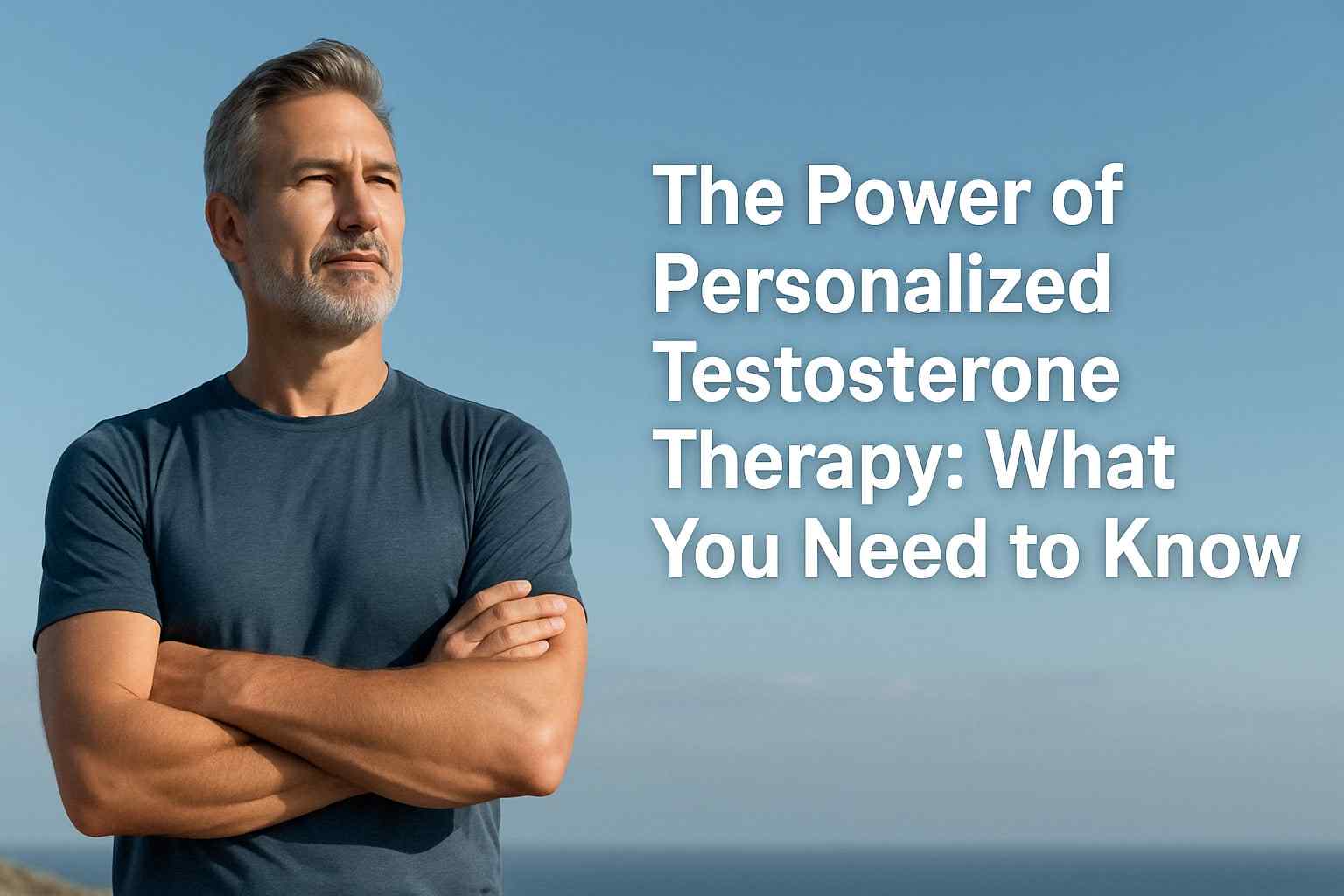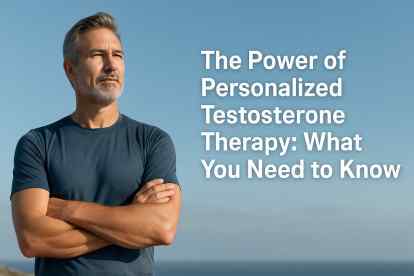Compounded Bioidentical Testosterone: A Personalized Approach to Men's Health

Testosterone plays a vital role in a man’s strength, energy, mood, metabolism, and sexual health. But with age—or sometimes due to stress, medications, or environmental toxins—testosterone levels can decline. If you're feeling fatigued, losing muscle mass, struggling with libido, or noticing mood changes, low testosterone may be the culprit.
One highly effective and safe option for restoring hormone balance is compounded bioidentical testosterone, especially when delivered through customized topical formulations. Here’s what you need to know about how it works, how it's different from synthetic steroids, and why more men are turning to this personalized solution.
Compounded bioidentical testosterone is a prescription medication made by a compounding pharmacy to match your individual needs. It is chemically identical to the testosterone your body naturally produces—unlike synthetic versions such as anabolic steroids.
Topical compounded testosterone is applied directly to the skin (usually in cream or gel form), allowing the hormone to be absorbed into your bloodstream for steady, physiological delivery.
There’s a major difference between bioidentical hormone therapy and synthetic anabolic testosterone “like” steroids such as Oxandrolone.
Risks With Synthetic Anabolic Steroids:
- Not structurally identical to natural testosterone
- High doses suppress natural hormone production
- Can cause liver damage, infertility, aggression, hair loss, and cardiovascular risks
- Often used in bodybuilding, not medical therapy
Benefits of Compounded Bioidentical Testosterone:
- Mimics your body’s natural hormone structure (and rhythm if desired)
- Safer long-term profile with lower risk of side effects
- Can be precisely dosed and adjusted based on your labs and symptoms
- Supports healthy estradiol and DHT conversion
- Preserves fertility when combined with hCG
When you take testosterone—especially in topical or injectable forms—your body doesn’t just use it “as is.” It metabolizes testosterone into two key hormones:
1. Estradiol (E2)
- Created through the aromatase enzyme
- Plays a critical role in brain, bone, and cardiovascular health
- Too little estradiol can lead to anxiety, hot flashes, joint pain, and even increased risk of heart failure
- Too much estradiol (especially in overweight men) may cause mood issues, water retention, or breast tissue development (gynecomastia)
2. Dihydrotestosterone (DHT)
- Formed through 5-alpha reductase
- 5x more potent than testosterone at the androgen receptor
- Critical for libido, erectile function, prostate health, and muscle strength
- Excessive DHT can be linked to hair loss or prostate enlargement in some men
Topical testosterone treatments (like gels or creams) tend to lead to less conversion to estradiol (E2) compared to injectable testosterone, and potentially a higher conversion to DHT.
Why?
- Lower Estradiol:
Estradiol is made via the aromatase enzyme, which is more active in fat tissue. Since topical testosterone delivers smaller, steadier amounts compared to the sharp peaks from injections, there's less circulating testosterone to be aromatized, resulting in lower estradiol conversion overall. - Increased DHT:
DHT is made by the enzyme 5α-reductase, which is found in high amounts in the skin—especially on the scalp, chest, and genitals. If topical testosterone is applied to these areas, it can pass through these DHT-rich tissues and lead to higher levels of DHT in the body. This may raise the risk of side effects like hair loss, acne, or prostate enlargement in some men. However, testosterone creams and gels are usually applied to areas with thinner skin, more fat, and good blood flow—such as the upper inner arms or inner thighs—which may reduce this risk.
This difference in metabolism is one reason why therapy choice (topical vs injectable) should be personalized and monitored with regular labs, especially in men with symptoms of estradiol like mood swings or gynecomastia.
Your practitioner may use one of two strategies to dose topical testosterone:
1. Static Dosing
This is the most common method and involves applying the same dose once to twice daily to maintain steady blood levels. Pretty straightforward.
2. Rhythmic Dosing
This method of testosterone therapy is designed to copy the body’s natural hormone patterns—how testosterone and DHEA rise and fall each day and even change a little with the seasons. In healthy men, testosterone is usually highest in the morning and drops in the evening. It can also be a bit higher in the summer and lower in the winter. Most treatments don’t follow this natural rhythm.
By timing the doses to match these natural patterns, this approach helps keep hormone levels more steady and balanced. That can lead to better mood, energy, sex drive, and overall well-being.
This can be especially helpful for couples—if a woman is doing hormone therapy that follows a natural rhythm, and her male partner is too, their hormones can be in sync. That might help them feel more connected, improve intimacy, and support a stronger relationship.
The vehicle is the base that carries testosterone through the skin. It’s a critical factor in how well the hormone absorbs into your system.
Common Vehicles:
- Alcohol-Based Gels: Fast drying, easy to apply, but may irritate sensitive skin and pose a higher risk of transference.
- Creams: Smooth and moisturizing, less risk of irritation. Slower absorption but excellent for steady delivery. This option is our vehicle of choice!
- Liposomal Creams: Encapsulated testosterone in lipid-based vesicles for enhanced penetration. Ideal for men with absorption issues.
Your doctor or compounding pharmacist will help select the best option based on your skin type, absorption needs, and lifestyle.
One key advantage of compounded testosterone is the ability to customize or enhance excipients—inactive ingredients that support optimal skin penetration and improve the effectiveness of transdermal hormone delivery.
Common Examples:
- Isopropyl Myristate: A common skin-penetration enhancer that helps improve absorption through the stratum corneum.
- Ethoxy Diglycol: A gentle solvent that increases testosterone solubility and assists in dermal penetration.
- DMSO (Dimethyl Sulfoxide): A highly potent absorption enhancer that can elevate hormone delivery significantly—up to 4x compared to ethoxy diglycol. Due to its strength, it should only be used under expert supervision.
Choosing the right excipients (and amounts) ensures you get the hormone levels you need—without requiring high doses.
Topical compounded testosterone is often provided in precise, measured-dose applicators—making daily use simple, consistent, and convenient.
- Topi-Click® Dispensers: Dispense a set amount (e.g., 0.5g per 2 clicks) per use
- Airless Pump Bottles: Hygienic and precise (0,5g per pump)
- Syringes: Our most used device because of its accuracy, customization and ease of use.
These tools ensure consistency and ease—so you don’t have to guess your dose.
Some compounded testosterone creams include additional hormones or nutrients to enhance results:
- DHEA: Supports adrenal function and boosts mood and libido. DHEA, along with thyroid, is also a key factor in making sure testosterone is received by the body.
- Chrysin: A natural aromatase inhibitor that helps balance estrogen levels.
- Pregnenolone: Supports memory, mood, and neuroprotection
Why Combine?
Hormones function as an interconnected system—not in isolation. Focusing on testosterone alone may fall short of achieving true hormonal balance. That’s why many practitioners choose to combine testosterone with supportive hormones like DHEA and Pregnenolone, two of the most popular and effective additions for enhancing overall results and restoring optimal function.
While compounded topical testosterone is effective and safe for many men, it’s not appropriate for everyone. Certain situations require caution—or may rule it out entirely.
You should not use topical testosterone if:
- You live with or frequently care for small children
Testosterone can transfer through skin-to-skin contact, especially to young children. Even trace amounts can affect a child’s hormone development, leading to premature puberty or other hormone-related issues. If you can’t reliably cover the application area and prevent contact, a non-topical form (like injections) may be safer. - You have a history of hormone-sensitive cancers
While research shows that testosterone therapy does not increase prostate cancer risk in most cases, caution is needed in men with a history of active or untreated prostate or breast cancer. A healthcare provider will help determine if TRT is appropriate and what monitoring is needed. - You are trying to conceive
Topical testosterone (and all external testosterone therapies) can suppress natural sperm production, leading to infertility. If fertility is a goal, alternatives like hCG or Clomid may be recommended. - You have serious liver, kidney, or heart disease
These conditions may increase your risk of complications from testosterone therapy, particularly if not well controlled. A full medical evaluation is essential before starting treatment.
Topical testosterone isn’t ideal for everyone—especially those with young children at home (due to transference risk) or those with sensitive skin. Fortunately, Harbor Compounding Pharmacy offers a wide range of customized testosterone delivery options to suit your needs and lifestyle:
Alternative Delivery Options
- Oral Capsules
Compounded in immediate or sustained-release formats and tailored to any concentration, capsules are ideal for men who travel frequently, prefer a no-mess solution, or want something that doesn’t require special storage. - Sublingual Troches and Drops
These formulations bypass the digestive system and are gentler on the liver compared to traditional oral tablets. They are ideal for patients concerned about liver stress or those looking for a convenient, fast-absorbing alternative.
Most troches require refrigeration, but we also offer a specially compounded room-temperature base—perfect for added convenience.
The right amount of testosterone is completely different for every male. As such, there is no one-size-fits-all dosage that will work across the board. Compound medications offer a customized approach that takes into account the patient’s unique medical history, needs, and lifestyle.
Here are the advantages of compound medication over mass-market alternatives:
Safe and high quality – Uses only the highest-quality form of testosterone that meets the strictest safety and requirements established by US professionals
Custom doses – Upon instruction from the doctor, compound medication dosages are tailored to fit the patient’s requirements perfectly
Affordable – Compounding pharmacies typically offer medications at a fraction of what commercially available testosterone therapies cost
Convenience – Aside from customized dosages, compounding pharmacies can also personalize the form medication, making it more palatable, easier to take, and combined with other hormones such as chrysin and DHEA
Want to explore your options or ask questions about getting started? Reach out to a hormone-trained healthcare provider or contact Harbor Compounding Pharmacy for expert guidance.
References
- Ullah MI, Riche DM, Koch CA. Transdermal testosterone replacement therapy in men. Drug Des Devel Ther. 2014;8:101-112.
- Androderm [package insert]. Markham, Ontario: Allergan Inc.;2018
- Gooren LJ, Bunck MC. Androgen replacement therapy: present and future. Drugs. 2004;64(17):1861-1891.
- Rothenberg R, Hart K, Rothenberg R. Hormone Optimization in Preventative/Regenerative Medicine.2nded. Encinitas, CA: Panda Press
- Wang C, Nieschlag E, Swerdloff R, et al. Investigation, treatment and monitoring of late-onset hypogonadism in males: ISA, ISSAM, EAU, EAA and ASA recommendations. Eur J Endocrinol. 2008;159(5):507-514.
- Aydogdu A, Swerdloff RS. Emerging medication for the treatment of male hypogonadism. Expert Opin Emerg Drugs. 2016;21(3):255-266.
- Park HJ, Ahn ST, Moon DG. Evolution of Guidelines for Testosterone Replacement Therapy. J Clin Med. 2019;8(3).
- Basaria S, Dobs AS. New modalities of transdermal testosterone replacement. Treat Endocrinol. 2003;2(1):1-9.



